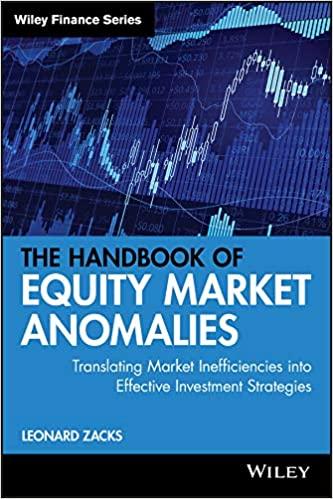Question
1. Calculating real returns vs. nominal returns requires a forecast of expected future inflation we can see a bonds inflation risk: a. Decreases with its
1. Calculating real returns vs. nominal returns requires a forecast of expected future inflation we can see a bonds inflation risk: a. Decreases with its time to maturity b. Unaffected by its time to maturity c. Increases with its time to maturity d. Presents no difference in real vs. nominal returns
2.
Common stock equities - are risky because:
a_Prices can fall to zero
b)Lack of transparency in some equity markets
c)Shareholder are primary claimants
d)Shareholders are residual claimants
3.
Hedging with credit default swaps, as a form of insurance, allows for:
a)Equity ownership of a corporate bonds
b)Increased exposure to counterparty default risk
c)Decreased exposure to counterparty default risk
d)Ability to short mortgage market exposure
4.Banks are heavily regulated because they safeguard individual savings and because they are inherently fragile the primary risk of a banks fragility is known as:
a)Interest rate risk mismatch in maturities of a banks asset vs. liabilities
b)Credit risk default risk of borrowers on their loans
c)Liquidity risk risk of sudden depositor withdrawals vs. long-dated bank assets
d)Trading risk trading losses in the banks own account
5.
Financial intermediaries perform 5 main functions, they are:
a)Pool savings, safekeeping & accounting, provide liquidity, diversify risk and process equity transactions
b)Pool savings, safekeeping & accounting, provide leverage, diversity risk and process information
c)Pool savings, safekeeping & accounting, provide liquidity, diversify risk and collect & process information services
d)Pool savings, safekeeping of precious metals, provide liquidity, diversify risk and collect & process information services
6.Banks balance sheets consist of assets, liabilities and capital, what are the 4 largest sources of commercial bank assets:
a.Mortgage-backed securities, consumer loans, equity investments and cash
b.Cash, securities, real estate and loans
c.Stocks, bonds, loans and cash
d. C&I loans, consumer loans, stocks and car loans
7.
Three broad measures of bank profitability are:
a.NIM, NII and ROA
b. ROE, NII and net worth
c. ROA, ROE and NII
d. EBITDA, ROTC and EPS
8.
Select the 3 measures of capital ratios disclosed by US banks:
a.RWAs, GAAP and IFRS
b.Assets, Liabilities and Capital
c.Net Worth, Liquidity and Solvency
d.RWAs, CECL and the Dividend Discount Model
9.
Regulation and supervision of the financial system include 3 risk mitigation strategies to balance the safety net, which are:
a.Regulation, supervision and enforcement
b.Enforcement, supervision and protection
c.Audit, compliance and licensing
d.Regulations, supervision and examination
10.
Central banks are financial institutions that do which if the following 3 functions:
a.Manages the governments finances, controls availability of money & credit and serves as the bank to commercial banks
b.Manages monetary policy, controls commercial banks and supervises credit unions
c.Manages the government budget, controls commercial banks corporate governance and regulates the stock markets
d.Manages monetary policy, manages fiscal policy and promotes economic growth
11
Step by Step Solution
There are 3 Steps involved in it
Step: 1

Get Instant Access to Expert-Tailored Solutions
See step-by-step solutions with expert insights and AI powered tools for academic success
Step: 2

Step: 3

Ace Your Homework with AI
Get the answers you need in no time with our AI-driven, step-by-step assistance
Get Started


